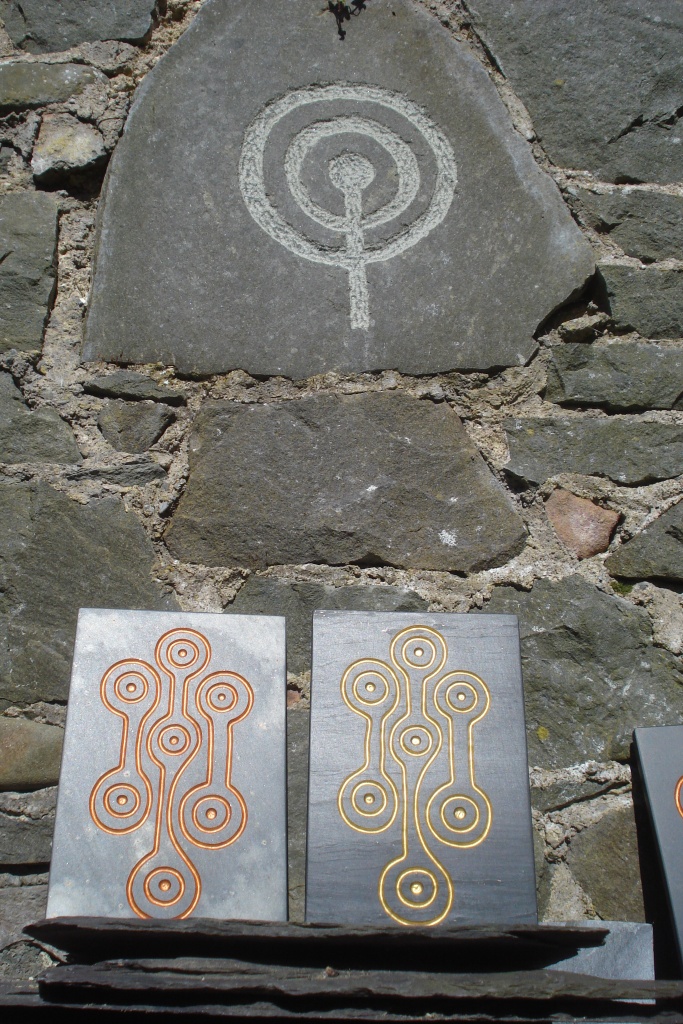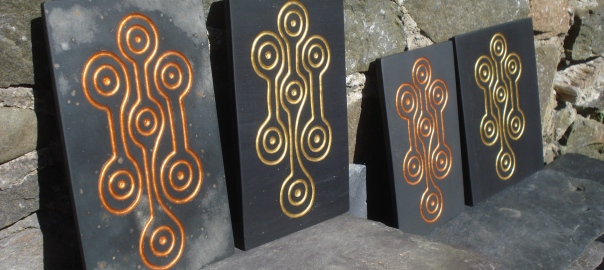Four new copper and gold ‘Runic Cross’ plaques (one 13 x 16 cm, three 10 x 16 cm). Hand cut, carved and polished from pieces of reclaimed roofing slates. Finished with metallic gold or metallic copper sign-writers enamel and a coat of Lithofin MN slate protector/enhancer. These are available to buy only from The Hub On The High Street in Innerleithen.

This cup-ring-channel design is based on the carvings found on the ‘Runic Cross’ that is now housed inside a church in Innerleithen, Scottish Borders. Having carved this design a few times, I’m always left wondering about the ‘Runic Cross’ stone- it just doesn’t make sense in any archaeological context!
The stone was discovered by a local master builder and stonemason, Robert Mathison, in 1871. He was demolishing the old Parish Church in Innerleithen with a view to reusing the stone to build another house in the town. During the work he found in ‘the lowest course of mason work of the south side wall’ a white sandstone block around 81 cm high carved on all four sides with cups, rings and channels.
The earliest published account of the discovery that I have found is from Volume 9 of the History of the Berwickshire Naturalists’ Club printed in 1882. It is often stated that this stone was an early cross shaft found with the original base which was broken up, but in Mathison’s account of the discovery, he makes no mention of the base and doesn’t allude to the fact that this was once a complete cross. In Mathison’s drawing of the west face of the stone, it’s titled as a ‘sculptured pillar’. The introduction to his account states that the stone was ‘perhaps’ the shaft of an ancient cross, but this was written by James Hardy, not Mathison. It should also be noted that the carving on the east face of the stone is complete (within the 81 cm height).
If this was a highly-revered Christian relic as it’s often claimed, then why was it used in the lowest foundations of the church? Does this carved stone not represent another example of a monument that was ‘Christianised’ by having a church built on top?
Although I’m alluding to the fact that the carvings on this stone are similar to Early Bronze Age rock art (with the motifs of cupmarks, complete rings, gapped rings and variants), again, this doesn’t really make sense. The stone is almost rectangular in section with carvings on all four sides- I have yet to see anything resembling this in rock art databases, books and publications.
We’re back to Robert Mathison who wasn’t only a stonemason, but also a keen historian and amateur archaeologist. In 1871, he also built a house for himself (using sandstone in the construction) which he named ‘Runic Cross’. The stone he found in the foundation material of the church was on display in the garden of his house for a number of years. Could it be (and this is a bit of a jump to a conclusion!) that the ‘Runic Cross’ was actually the work of Mathison himself as a small garden folly (that was a trend in the 18th and 19th Centuries) to create a mythology around his house?
If you have ideas, insights or further information, I’d be very interested to hear your thoughts!
References;
https://canmore.org.uk/site/53174/innerleithen-parish-church
https://portal.historicenvironment.scot/designation/LB51090
https://www.pastinnerleithen.com/people/robert-mathison
https://archive.org/details/historyofberwick09berw/page/n575/mode/2up
